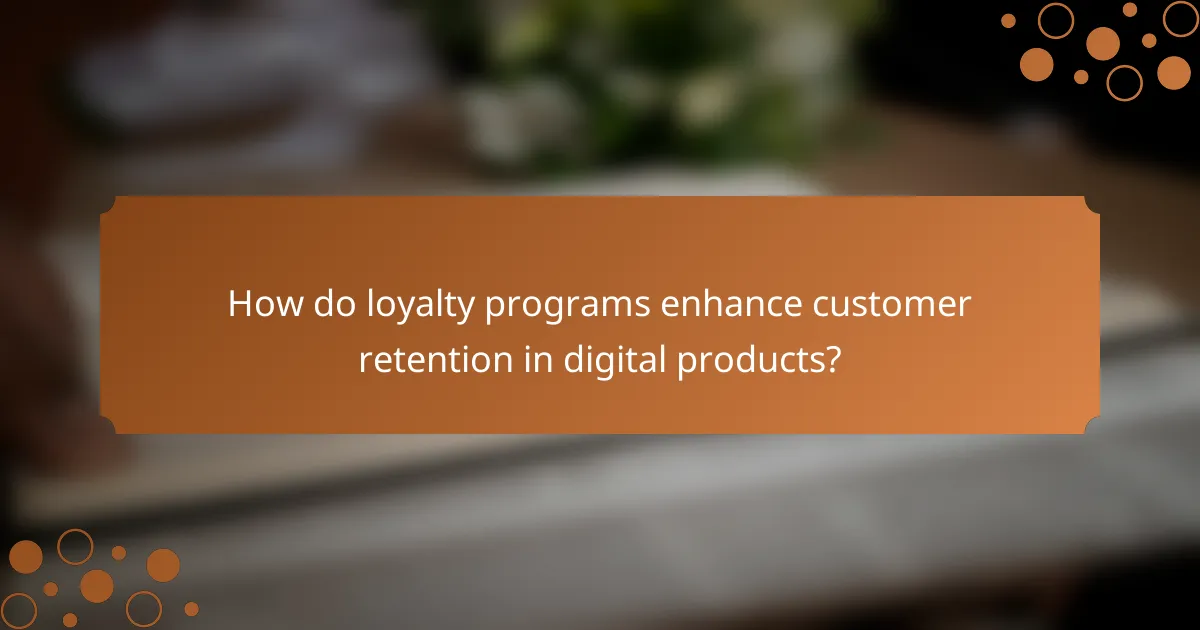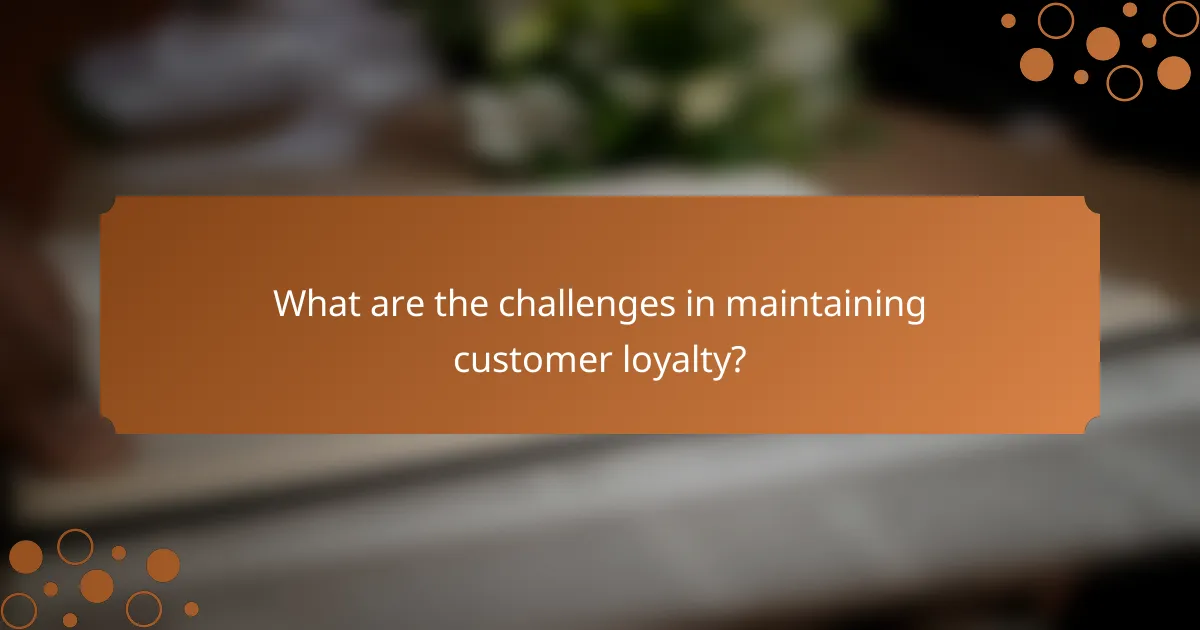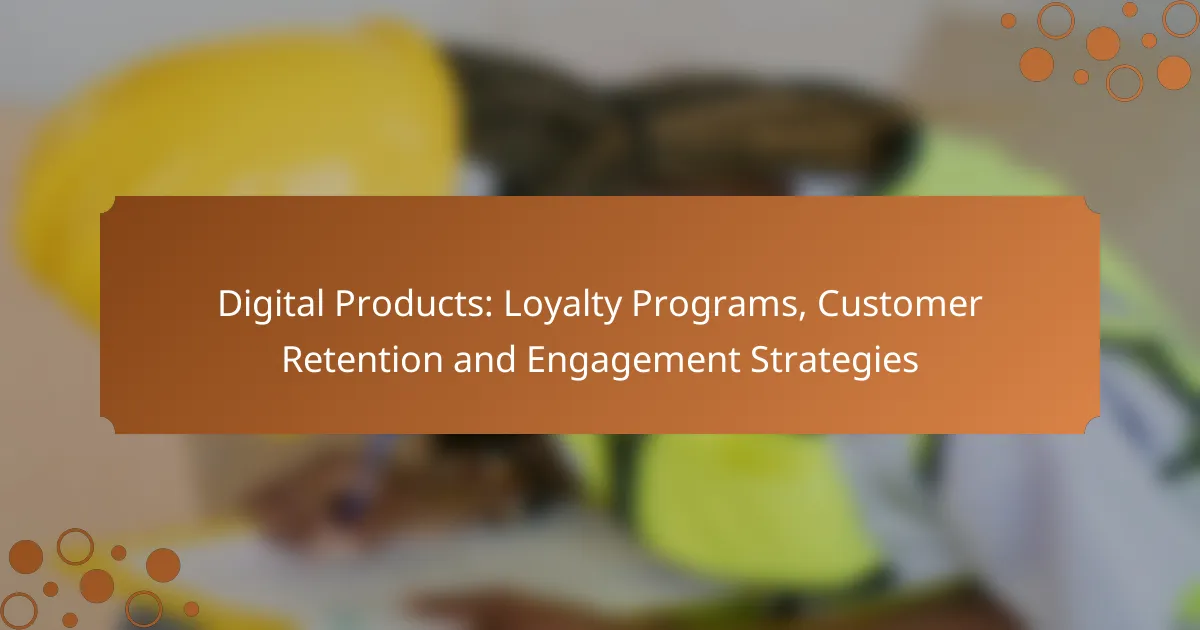In the competitive landscape of digital products, loyalty programs play a crucial role in enhancing customer retention by incentivizing repeat purchases and deepening emotional connections with brands. By implementing effective engagement strategies that leverage technology and personalization, businesses can create meaningful interactions that not only boost user satisfaction but also foster a loyal community around their products.

How do loyalty programs enhance customer retention in digital products?
Loyalty programs enhance customer retention in digital products by incentivizing repeat purchases and fostering a stronger emotional connection with the brand. These programs typically offer rewards that encourage customers to engage more frequently with the product, leading to increased satisfaction and loyalty.
Increased customer engagement
Loyalty programs drive increased customer engagement by providing users with reasons to interact with the brand more often. For example, earning points for every purchase or activity can motivate users to explore additional features or products. This consistent interaction helps build a habit around the brand, making it a go-to choice for consumers.
Moreover, engaging customers through personalized communications, such as targeted promotions or exclusive offers, can further enhance their connection to the brand. This tailored approach ensures that customers feel valued and understood, which can significantly boost their loyalty.
Higher repeat purchase rates
Implementing a loyalty program can lead to higher repeat purchase rates as customers are more likely to return for rewards. Research indicates that customers enrolled in loyalty programs tend to spend more over time compared to non-members. This is often due to the perceived value of accumulating points or rewards that can be redeemed for discounts or free products.
To maximize repeat purchases, businesses should consider tiered loyalty programs that reward customers for reaching certain spending thresholds. This strategy not only encourages initial purchases but also motivates customers to increase their spending to unlock higher rewards.
Personalized rewards systems
Personalized rewards systems are crucial for enhancing the effectiveness of loyalty programs. By analyzing customer data, businesses can tailor rewards to individual preferences, making them more appealing. For instance, a customer who frequently buys coffee may appreciate a free drink after a certain number of purchases, while another who prefers pastries might value discounts on baked goods.
Additionally, offering a mix of rewards—such as exclusive access to new products or special events—can cater to diverse customer interests, further enhancing engagement and retention. This personalization fosters a sense of belonging and loyalty among customers.
Case study: Starbucks Rewards
Starbucks Rewards is a prime example of a successful loyalty program that enhances customer retention. Members earn stars for every purchase, which can be redeemed for free drinks and food items. This straightforward rewards system encourages frequent visits and larger purchases, as customers aim to accumulate more stars.
The program also incorporates personalized offers based on purchase history, enhancing the customer experience. By providing tailored promotions and rewards, Starbucks has successfully created a loyal customer base that consistently returns for their favorite beverages and snacks.

What are effective customer engagement strategies for digital products?
Effective customer engagement strategies for digital products focus on fostering meaningful interactions that enhance user experience and loyalty. These strategies often leverage technology to personalize communication, create interactive experiences, and build community around the product.
Gamification techniques
Gamification techniques involve incorporating game-like elements into non-game contexts to boost user engagement. This can include rewards, challenges, and leaderboards that motivate users to interact more frequently with the product.
For example, a fitness app might offer badges for completing workouts or a loyalty program that rewards points for each purchase. These incentives encourage users to return regularly and deepen their connection with the product.
Personalized email marketing
Personalized email marketing tailors messages to individual users based on their preferences and behaviors, significantly increasing engagement rates. By segmenting your audience and sending targeted content, you can make your communications more relevant and appealing.
Consider using data analytics to track user interactions and preferences. For instance, sending tailored recommendations based on past purchases can lead to higher conversion rates and customer satisfaction.
Social media interaction
Social media interaction is crucial for engaging customers in a dynamic and conversational manner. Brands can use platforms like Facebook, Instagram, and Twitter to respond to customer inquiries, share updates, and gather feedback.
Encouraging user-generated content, such as reviews or photos, can also enhance community engagement. Regularly interacting with followers through polls, contests, or Q&A sessions can foster a sense of belonging and loyalty among users.

How can businesses measure the success of loyalty programs?
Businesses can measure the success of loyalty programs through various metrics that reflect customer engagement and retention. Key indicators include customer lifetime value, retention rates, and net promoter scores, which provide insights into how well a loyalty program is performing.
Customer lifetime value (CLV)
Customer lifetime value (CLV) estimates the total revenue a business can expect from a customer throughout their relationship. To calculate CLV, consider average purchase value, purchase frequency, and customer lifespan. For example, if a customer spends $100 per purchase, buys twice a year, and remains loyal for five years, their CLV would be $1,000.
Monitoring CLV helps businesses understand the long-term impact of loyalty programs. A rising CLV indicates that customers are not only returning but also spending more, which is a positive sign of program effectiveness.
Retention rate analysis
Retention rate analysis measures the percentage of customers who continue to engage with a business over a specific period. To calculate retention rate, divide the number of retained customers by the total number of customers at the beginning of the period, then multiply by 100. For instance, if a business starts with 200 customers and retains 150, the retention rate is 75%.
High retention rates often correlate with successful loyalty programs, as they indicate that customers find value in returning. Regularly analyzing retention rates can help identify trends and areas for improvement in customer engagement strategies.
Net promoter score (NPS)
Net promoter score (NPS) gauges customer loyalty by asking how likely customers are to recommend a business to others on a scale from 0 to 10. Customers are categorized into promoters, passives, and detractors based on their scores. The NPS is calculated by subtracting the percentage of detractors from the percentage of promoters.
A high NPS suggests that customers are satisfied and willing to advocate for the brand, which is often a result of effective loyalty programs. Businesses should regularly survey customers to track NPS and use feedback to enhance their loyalty strategies.

What are the best practices for implementing a loyalty program?
Implementing a loyalty program effectively requires a strategic approach that aligns with your business goals and customer needs. Best practices include defining clear objectives, selecting the right technology, and ensuring a seamless user experience.
Define clear goals
Establishing clear goals is essential for a successful loyalty program. These goals should focus on customer retention, increased spending, or enhanced engagement. For example, aim to boost repeat purchases by a specific percentage over a defined period.
Consider using SMART criteria—Specific, Measurable, Achievable, Relevant, and Time-bound—to frame your goals. This clarity will guide your program design and help measure its success effectively.
Choose the right technology platform
Selecting the appropriate technology platform is crucial for managing your loyalty program efficiently. Look for solutions that integrate easily with your existing systems, such as CRM or e-commerce platforms, to streamline operations.
Evaluate options based on scalability, user interface, and customer support. Popular platforms often offer features like data analytics, mobile accessibility, and customizable rewards, which can enhance the overall effectiveness of your program.
Ensure user-friendly experience
A user-friendly experience is vital for encouraging participation in your loyalty program. Simplify the sign-up process and ensure that customers can easily understand how to earn and redeem rewards. Clear communication about program benefits can significantly enhance engagement.
Consider incorporating mobile apps or digital wallets to facilitate easy access to rewards. Regularly gather feedback from users to identify pain points and make necessary adjustments to improve their experience.

What are the challenges in maintaining customer loyalty?
Maintaining customer loyalty involves navigating various challenges that can impact retention and engagement. Key issues include intense market competition and shifting consumer preferences, which require businesses to adapt their strategies continually.
Market competition
Market competition is a significant challenge for customer loyalty, as numerous brands vie for the same customer base. Companies must differentiate themselves through unique value propositions, quality products, and exceptional customer service to stand out.
To effectively compete, businesses should regularly analyze competitors’ offerings and customer feedback. This can help identify gaps in the market and opportunities for innovation, ensuring that the brand remains relevant and appealing.
Changing consumer preferences
Consumer preferences are continually evolving, influenced by trends, technology, and social factors. Brands must stay attuned to these changes to meet customer expectations and maintain loyalty.
Conducting regular surveys and utilizing data analytics can provide insights into customer behavior and preferences. Adapting marketing strategies and product offerings based on this feedback is crucial for retaining customers in a dynamic marketplace.
